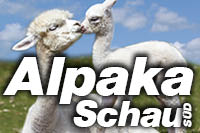Articles by Alpaca World Magazine:
Showing Off
Julie Taylor-Browne
Showing Off ? have fun training your alpaca for the show ring?
Julie Taylor-Browne,
Founder CamelidSense and Camelidynamics Instructor
On being asked to write this article, I had a vague recollection of having written before on this topic so I dredged through my somewhat inadequate filing system and reviewed what I thought five years ago compared to now .
Three things stood out for me as being the same and three things stood out for me as being different. So what had changed in the interim?
Well, I have definitely had more camelid experience but my own self-directed CPD (continuing professional development) studies have also contributed to my increased awareness of how animals (and humans) respond to learning and to stress. Discoveries in the field of neurobiology have confirmed what Linda Tellington-Jones, Marty McGee Bennett and Karen Pryor all knew through observation.
So here are the three key things that haven?t changed:
1. Halter fit. A correctly fitting halter that relies on the crown piece ? the part of the halter which goes around the back of the head ? and not an over-tightened nose band to keep the noseband back in the safe place on the nose bone, just in front of the eye. If the halter isn?t held in the correct place it will slip forward on the nose bone onto the cartilage and convince the animal that it is going suffocate ? this causing it to act out in an effort to escape from its halter. Marty McGee Bennett once wrote an article on this topic called something like ?Major Behavioural Changes in 30 seconds?, because it can make that much difference. Nowadays in the UK, thankfully, ring stewards are more aware of the effect of a badly fitting halter and will often insist on either adjustments or the replacement of a halter before the alpaca is allowed in the ring.
Fig. 1. Correctly fitting halter with lead rope clipped to the side.
2. Leading lightly from the front. Teaching your alpacas to lead properly makes a huge difference. We see too many alpacas in the show ring that don?t lead particularly well, jogging along in front of the handler, or lagging behind and having to be pulled along. This makes it hard for the judge to assess how they move and their conformation. Those who walk well, with self-carriage and who show themselves off so much better, they automatically have an advantage over those that don?t. Clip your lead rope to the most forward part of the most forward ring on the noseband and not the ring underneath the chin and you will find leading much easier, as will your alpaca.
Fig. 2. Teaching leading with a wand
By leading well, I mean that they are behind you, with a short length of slack lead between them and you. You aren?t relying on any pressure on the lead to either pull them along, hold them back from running past you or to give stop signals. When I teach my alpacas to lead I do it using a TTeam wand which gives them a visual cue to follow, making the giving of directions easy and teaching them the correct position vis a vis my body. Obviously I don?t take the wand into the ring, but by then they have learned how to follow my directions and stop neatly and in balance on my visual cues. I try to never use any force or pressure in the leadrope to stop the alpaca.
3. Show preparation. I prepare my animals for showing in a number of ways;
Hands on work. I work with them in a small pen so that I can keep them in balance and don?t have to restrain them. If I grab and hold them, inevitably I throw the alpaca and myself out of balance. Once they are out of balance, they can?t do anything but panic and are not learning anything I am trying to teach them.
My aim is to teach the alpaca that being touched all over isn?t necessarily a bad thing. I start doing this preparation by using Tellington Touch. I show the alpaca that it is potentially going to have its teeth, ears, topknot, neck, shoulder, midside, hip, tail and testicles examined, and that it can be ok for this to happen. Some judges even look at fibre down the legs ? and I give them 10/10 for bravery here! My secret weapons here are Tellington touch and clicker training. Please come on a course if you wish to know more! I then take the ?show on the road? when they are comfortable with this in the pen and practice ?fleece inspection? outside the pen and then in my mock show ring.
Practice what will happen at the show? I also like to do some preparatory work in introducing them to what a show ring looks like (we mock one up with horse posts and tape) and how the judge and ring steward are likely to approach the animal and what they will do.
Fig. 3. The mock judge and ring steward?
One tip I highly recommend is to show the teeth to the judge without putting your hand over the alpaca?s neck to the side furthest away from you. I have no idea why this is standard practice when it is so much easier for us and for the animals to do it on the side closest to you. Again, practise this before the show. Hold the halter with your right hand to give you the control you need over the head and simply ?scissor? with the index and middle fingers on your left hand.
Fig. 4. Easy teeth!
One extra stage I always include is the aptly named ?going away and coming back exercise?. We are all slightly apprehensive when it works out that our alpaca is going to be the first in the ring, particularly the youngsters. It has to leave its newly acquired herd in the collecting ring and then walk into a vast open space all on its own. Given that we know that alpacas are prey animals and that being separated from the herd is normally rather bad news in terms of your vulnerability to predators this reluctance is understandable. However we can train them to tolerate this by doing the following exercise. Take 3 or more alpacas on lead ropes out of their comfort zone (i.e. their field) to an area they don?t know or don?t know very well. Walk one of them away from the other two, and when you get to about 20 metres stop with your alpaca and do something nice, give it a treat or some TTouch. Then walk calmly back to the other two. Using a TTeam wand can help slow them down on the walk back. Repeat with the other two alpacas. Repeat the exercise gradually increasing the distance, but if they are even wobbly about the 20m, try the exercise at 10m or even 5m. Don?t push this exercise ? less is more is the key to all training, although this doesn?t mean you can do nothing!
Expect the unexpected. It is generally understood that if you expose an animal (including ourselves) to a new experience and we survive or even enjoy it, we are more mentally prepared and better able to cope with another new experience. Now I am not saying that you need to prepare your animals for showing by taking them on day trips out to see the world (although they would probably enjoy it?), but there is a reasonable amount you can do to prepare your alpaca for all the fun of the fair.
Fig. 5. Use whatever obstacles you have!
This could include working them through obstacles and getting them accustomed to listening to you whilst focusing on the task in hand; walking them round the farm and letting them meet hens, tractors, cars, multiple people, laden washing lines, shops, children in pushchairs and all the things that go on in our general lives ? but not theirs? Make sure you have trained them to go into a trailer otherwise the loading and unloading will stress them and think about the disinfection mats!
The Mats!!!! I see too many alpacas struggling with these and many of them cope by jumping over them, rather defeating the object I would have thought. You can prepare your alpaca for going over different surfaces by using the approach of ?chunking it down?. This means starting off with something they find easy and non-threatening and then increasing the challenge. The way I familiarize my animals with scary surfaces such as mats is to take two pieces of tarpaulin/pvc/plastic tablecloth and place them at least a yard apart. If it is windy, weigh these down with something. A new surface is hard enough to encounter without it blowing up and attacking you too! Walk your alpaca between the two halves. If they want to look at it, let them and don?t hurry them through. Narrow the space between the two and walk them between it again. If they don?t want to go through and ?plant?, make the space wider again and walk them through, next time narrow it only slightly. Finally cross one side slightly at the corner (thus making it wider at the other end) and walk them over the 2-3 cms of ?solid? tarpaulin, next time cross it more until they are comfortably walking over it. This may take 15 minutes spread over 3 days, but once you have done it, you have an alpaca who is not spooked by new surfaces (including indoor show rings and trailer ramps), a time investment worth making I would have thought.
Fig. 6 First the easy part?..
Fig. 7?and then the more challenging?.
The above covers what I still believe to be the basics of show preparation, but I now also believe there is more we can and should do to make showing if not exactly fun, at least less stressful for both handler and alpaca.
Do something about you. The best handlers I have seen are those who are attuned to the alpaca in hand. They watch, listen and anticipate problems before they arise. They aren?t chatting to the other competitors in the collecting ring, they aren?t swinging or tugging on the alpaca?s lead rope whilst they wait to go in ring, waving at friends and family outside the ring or talking on their mobile phones. You can help yourself become a quiet, focused and calm handler. I suggest:
? breathing calmly and quietly;
? doing some TTouch on your animals to calm them (this also calms the person doing the TTouch);
? visualizing how you are going to handle the animal well in the ring (the Inner Game of showing?).
? identifying if you are tensing up anywhere e.g. in your arms, legs or back and the consciously relaxing there, and
? practicing being light with the lead rope.
Alpacas, being prey animals are acutely attuned to how other animals are around them. They continuously watch for signals such as turned heads, pausing of breath, tensing of muscles and unfamiliar actions ? these are their buttons for flight. By working on ourselves we are able to reassure them that they are in no danger and then, miraculously, they will behave better.
Change the context. Some alpacas have decided that they simply don?t like shows. They don?t mind the being in a pen with pals and nice hay, but the show ring bit is the pits. They remember their bad experience of shows from one show to another and they can get progressively worse as the season goes on. If at all possible do something to change the context. For example take your alpaca for a walk. It has been shown that just three minutes of exercise will lower cortisol (the stress hormone) and release endorphins (the feel good hormones). Even a change of scene before their turn in the ring will help to give the alpaca something else to look at and gets them interested. I?m not suggesting you take an obstacle course with you, (although some riders work their horses through a labyrinth made from cavaletti before entering the competition ring) but if you can find anything obstacle-esque to negotiate, this will also help them concentrate, focus and forget about being really fed up about being there. I have used parked cars as rather large weaving poles before now. If you can go from these exercises and then into the show ring, you will have a calmer, more focused alpaca. Another way to change the context is to start using positive reinforcement such as clicker training. Positive reinforcement makes the desirable behaviour more permanent, more quickly and involves the release of the ?feel good? hormones. Whilst you will probably not be obviously clicking and rewarding in the ring, you can certainly do it outside the ring and this will release tension and remind your alpacas about all the good things associated with training.
Melt down and recovery. Studies show that when an animal spooks or panics, the adrenalin and the other flight/fight chemicals which get released into their bodies is metabolized (broken down) within 90 seconds. Therefore if you refrain from either doing the same thing that provoked an unwanted response or it does not repeat itself (e.g. steam engines backfiring) within 90 seconds you will have a different animal. 90 seconds seems a long time when you think that everyone is looking at you, but you could always ask the judge to return to your animal in a minute or so. TTouch is a great thing to do for the animal (and you) to help regain equanimity.
I hope I have managed to give you a few ideas on training your alpacas for the show ring. There are many more tips and techniques that I don?t have space for, but I also hope I have shown you that investing a little time in preparation is well worth doing, not just if you are going to go to a number of shows but because working with alpacas and building a relationship with them is both fun and rewarding.
To find out more about handling and training alpacas have a look at my website, www.carthveanalpacas.com where I also sell equipment, books and DVDs. I can be contacted on taylor.browne@clara.net. You might also be interested in coming on a course. In the UK I am giving a three day course in June at Simply Alpaca (www.simplyalpaca.co.uk), and Marty McGee Bennett will be giving a four day advanced course in May at the same venue.
Tweet



